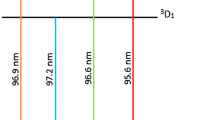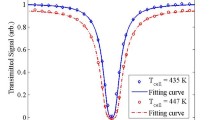Abstract
A critical evaluation of the experimental and theoretical literature regarding the rates for fine structure mixing in the first excited 2P3/2,1/2 states of potassium and rubidium induced by collision with 4He is performed. The evaluation is used to develop a recommendation for the fine structure mixing rates as a function of temperature. The rate coefficient for transitions from Rb 5 2P3/2 to 52P1/2 induced by helium ranges from 1.2 to 4.6 × 10–12 cm3 s−1 as temperature increases from 300–600 K. Remarkable agreement for the thermally average cross-sections is observed between the empirical, semi-classical perturbative, and quantum scattering theory approaches. In addition to collisions with 4He, new energy-dependent cross-sections for the K 42P mixing induced by 3He are reported using time-dependent channel packet scattering theory. The 3He rates are faster than for 4He due to both increased relative speed and more impulsive interactions. The fine-structure mixing rates in high-power Diode Pumped Alkali Lasers limit intensity scaling and are the primary source of heating. This heating induces spatial and temporal optical phase variations and accurate values for mixing rates as a function of temperature are critical for high fidelity laser modeling and simulation.









Similar content being viewed by others
References
W. F. Krupke, Diode pumped alkali laser. U.S. patent 6,643,311 (2003)
W.F. Krupke, R.J. Beach, V.K. Kanz, S.A. Payne, Resonance transition 795 nm rubidium laser. Opt. Lett. 28, 2336–2338 (2003)
G.A. Pitz, D.M. Stalnaker, E.M. Guild, B.Q. Oliker, P.J. Moran, S.W. Townsend, D.A. Hostutler, Advancements in flowing diode pumped alkali lasers. Proc. SPIE 9729, 972902 (2016)
A.V. Bogachev, S.G. Garanin, A.M. Dudov, V.A. Yeroshenko, S.M. Kulikov, G.T. Mikaelian, V.A. Panarin, V.O. Pautov, A.V. Rus, S.A. Sukharev, Diode-pumped caesium vapour laser with closed cycle laser-active medium circulation. Quant. Electron 42, 95–98 (2012)
J. D. Syring, USN Director, Missile Defense. Unclassified Statement of Vice Admiral. A Senate Armed Services Committee Subcommittee on Strategic Forces Wednesday, April 13, 2016
A. Gavrielides, L.A. Schlie, R.D. Loper, M.R. Hawks, G.P. Perram, Analytic treatment of beam quality and power efficiency in a high-power transverse flow diode pumped alkali laser. J Opt. Soc. Am. B. 35, 2202 (2019)
G.D. Hager, G.P. Perram, A three-level analytic mode for alkali metal vapor lasers: part I. narrowband optical pumping. Appl. Phys. B 101, 45–56 (2010)
J. Zweiback, G. Hager, W.F. Krupke, High efficiency hydrocarbon-free resonance transition potassium laser. Opt. Comm 282, 1871 (2009)
E.J. Hurd, J.C. Holtgrave, G.P. Perram, "Intensity scaling of an optically pumped potassium laser". Opt. Commun. 357, 63 (2015)
M. Endo, R. Nagaoka, H. Nagaoka, T. Nagai, F. Wani, Wave optics simulation of diode pumped alkali laser (DPAL). Proc. SPIE 9729, 972907 (2016)
H. Shu, Y. Chen, M. Bass, J.F. Monjardin, J. Deile, Numerical modeling of alkali vapor lasers. Opt. Express 19, 19875 (2011)
K. Waichman, B.D. Barmashenko, S. Rosenwaks, “Beam propagation in inhomogeneous medium of static gas Cs diode pumped alkali laser: three-dimensional wave optics and fluid dynamics simulation. J. Opt. Soc. Am. B 35, 558 (2018)
G.D. Chapman, L. Krause, Sensitzed fluorescence in vapors of alkali metals: VIII. Energy transfer between 4 2P levels in potassium induced by inelastic collisions. Can. J. Phys. 44, 753 (1966)
J.A. Jordan, P.A. Franken, Collision-induced mixing in the first excited states of sodium and potassium. Phys Rev 142, 20 (1966)
P.L. Lijnse, Electronic-excitation transfer collisions in flames-VII. Some alkali-doublet mixing cross sections for inert gas collisions, at 1720 K. J Quant. Spectrosc. Radiat. Transfer 14, 1195 (1974)
J. Ciurylo, L. Krause, 4 2P1/2↔ 4 2P3/2 mixing in potassium induced in collisions with noble gas atoms. J Quant. Spectrosc. Radiat. Transfer 28, 457 (1982)
R. Boggy, F.A. Franz, Cross sections for J, mJ -%3e J’, mJ’ transitions within the states of potassium induced by collisions with He, Ne, and Kr. Phys. Rev. A 25, 1887 (1982)
K.L. Krause, Collisional excitation transfer between the P212 and P232 levels in alkali atoms. Appl. Opt. 5, 1375 (1966)
R.W. Anderson, T.P. Goddard, C. Parravano, J. Warner, Crossed molecular beam-tunable laser determination of velocity dependence of intramultiplet mixing: K(4p 2P1/2)+He →K(4p 2P3/2)+He. J Chem Phys 64, 4037 (1976)
J.M. Mestdagh, J. Berlande, P. de Pujo, J. Cuvellier, A. Binet, Polarization effects in the P3/2→P1/2 fine structure transition cross section for K(4P)-He collisions. Z Phys. A Atoms. Nuclei 304, 3 (1982)
J. Cuvellier, J. Berlande, C. Benoit, M.Y. Perrin, J.M. Mestdagh, J. de Mesmay, Crossed-beam determination of energy dependence of fine-structure transitions in K (4P)–He collisions. J Phys B: Atom Molec. Phys 12, 461 (1979)
J. Pascale, Use of -dependent pseudopotentials in the study of alkali-metal-atom—He systems. The adiabatic molecular potentials. Phys. Rev. A 28, 632 (1983)
J.M. Mestdagh, J. Berlande, P. de Pujo, J. Cuvellier, A. Binet, Fine-structure transitions in K (4P) induced by rare gases and diatomic molecules. J. Phys. B: Atom. Mol. Phys 15, 439 (1982)
C.D. Lewis, D.E. Weeks, Theoretical cross sections of the inelastic fine structure transition M(2P1/2) + Ng ↔ M(2P3/2) + Ng for M = K, Rb, and Cs and Ng = He, Ne, and Ar. J. Phys. Chem. A 121, 3340 (2017)
E.E. Nikitin, Nonadiabatic transitions between fine-structure components of alkali atoms upon collision with inert-gas atoms. J. Chem. Phys 43, 744 (1965)
B. Eshel, J.A. Cardoza, D.E. Weeks, G.P. Perram, Role of adiabaticity in controlling alkali-metal fine-structure mixing induced by rare gases. Phys. Rev. A 95, 042708 (2017)
A. Gallagher, Rubidium and cesium excitation transfer in nearly adiabatic collisions with inert gases. Phys. Rev. 172, 88 (1968)
M.D. Rotondaro, G.P. Perram, Role of rotational-energy defect in collisional transfer between the levels in rubidium. Phys. Rev. A 57, 4045 (1998)
G.A. Pitz, C.D. Fox, G.P. Perram, Transfer between the cesium and levels induced by collisions with H2, HD, D2, CH4, C2H6, CF4, and C2F6. Phys. Rev. A 84, 032708 (2011)
L. Blank, D.E. Weeks, G.S. Kedziora, M+ Ng potential energy curves including spin-orbit coupling for M = K, Rb, Cs and Ng = He, Ne, Ar. J. Chem. Phys. 136, 124315 (2012)
J.M. Merritt, J. Han, T. Chang, M.C. Heaven, Theoretical investigations of alkali metal: rare gas interaction potentials. Proc. SPIE 7196, 71960H (2009)
W.F. Krupke, Diode pumped alkali lasers (DPALS): a review (rev1). Prog. Quantum Electron. 36, 4 (2012)
W. Berdowski, L. Krause, mJ mixing in oriented potassium atoms, induced by collisions with inert gases. Phys. Rev. 165, 158 (1968)
W. Berdowski, T. Shiner, L. Krause, Mixing in oriented potassium atoms induced by collisions with inert gases. Phys. Rev. A 4, 984 (1971)
M.D. Rotondaro, G.P. Perram, Collision-induced transitions between the Zeeman-split levels of Rb. Phys. Rev. A 58, 2023 (1998)
M.S. Child, Molecular collision theory (Dover Publications, Mineola NY, 1996)
C.D. Lewis, Non-adiabatic atomic transitions: computational cross section calculations of alkali metal–noble gas collisions. Ph.D. Thesis, Air Force Institute of Technology (2011)
W.S. Miller, C.A. Rice, G.D. Hager, M.D. Rotondaro, H. Berriche, G.P. Perram, High pressure line shapes of the Rb D1 and D2 lines for 4He and 3He collisions. J. Quant. Spectrosc. Radiat. Transfer 184, 118–134 (2016)
G.D. Hager, G.E. Lott, A.J. Archibald, L. Blank, D.E. Weeks, G. P. Perram. High pressure line shapes for Cs D1 and D2 lines and empirically informed interaction potentials. J. Quant. Spectrosc. Radiat. Transfer 147, 261–273 (2014)
T.J. Beahn, W.J. Condell, H.L. Mandelberg, Excitation-transfer collision between rubidium and helium atoms. Phys Rev 141, 141 (1966)
J.F. Sell, M.A. Gearba, B.M. Patterson, D. Byrne, G. Jemo, T.C. Lilly, R. Meeter, R.J. Knize, Collisional excitation transfer between Rb(5P) states in 50–3000 Torr of 4He. J Phys B At Mol Opt Phys 45, 055202 (2012)
R.E. Olson, Fine structure transition cross sections for several alkali+ rare gas systems. Chem. Phys. Lett. 33, 250 (1975)
R.E. Olson, Two-state Stueckelberg–Landau–Zener theory applied to oscillatory inelastic total cross sections. Phys. Rev. A 2, 121 (1970)
E.L. Lewis, C.S. Wheeler, A.D. Wilson, Relaxation of the orientation of the potassium resonance levels due to collisions with rare-gas atoms. J. Phys. B: At. Mol. Phys. 10, 2619 (1977)
B. Kamke, Disorientation and disalignment cross sections of excited Rb-atoms colliding with noble gases. Z. Phys. 273, 23 (1975)
Author information
Authors and Affiliations
Corresponding author
Additional information
Publisher's Note
Springer Nature remains neutral with regard to jurisdictional claims in published maps and institutional affiliations.
Rights and permissions
About this article
Cite this article
Weeks, D.E., Lewis, C.D., Schlie, L.A. et al. Temperature dependence of the fine structure mixing induced by 4He and 3He in K and Rb Diode Pumped Alkali Lasers. Appl. Phys. B 126, 79 (2020). https://doi.org/10.1007/s00340-020-07423-6
Received:
Accepted:
Published:
DOI: https://doi.org/10.1007/s00340-020-07423-6




